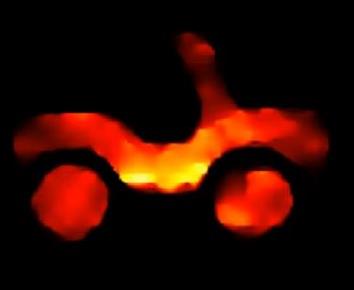About
30 June 2016
Imaging at the Speed of Light
30 June 2016
Imaging at the Speed of Light
Researchers enhance image quality for world’s fastest receive-only camera;
could enable imaging of ultrafast processes involving neurons, combustion and stars
could enable imaging of ultrafast processes involving neurons, combustion and stars
WASHINGTON — Researchers have improved upon a new camera technology that can image at speeds about 100 times faster than today’s commercial cameras while also capturing more image frames. The new technology opens a host of new possibilities for studying extremely fast processes such as neurons firing, chemical reactions, fuel burning or chemicals exploding.
A research team led by Lihong V. Wang, Gene K. Beare Distinguished Professor of Biomedical Engineering, Washington University, St. Louis, USA, previously developed a single-shot compressed ultrafast photography (CUP) camera that can image at speeds of 100 billion frames per second in a single camera exposure — fast enough to capture traveling light pulses. The camera is the world’s fastest camera that is receive-only, meaning that it can use available light for imaging and doesn’t need any additional illumination from a laser or other light source.
 |
||
| Using the improved version of CUP , researchers capture a high quality image showing laser light reaching different portions of the car at different times. Image Credit: Liren Zhu, Jinyang Liang and Lihong V. Wang, Washington University in St. Louis |
In The Optical Society's journal for high impact research, Optica, the researchers report on a new method that improves the resolution and quality of images captured with CUP. They demonstrate the CUP upgrades by capturing a movie of a picosecond laser pulse traveling through the air and also by pointing laser light onto a printout of a toy car to create a movie of the light reaching different portions of the car at different times.
Watching neurons fire
Wang and his colleagues are particularly interested in understanding how the brain’s neural networks operate. Using the new camera with a microscope could allow them to watch neurons fire by capturing extremely fast chemical processes called action potentials that travel through an axon at speeds that can reach more than 100 meters per second.
“We want to use our new camera to study a living animal’s neural network in action,” Wang said. “This would reveal how the neural network functions, not just how the neurons are connected. If you were to think of the neural network as streets in a city, right now we can see the layout of the streets, but we want to see the traffic to understand how the whole system functions.”
The improved image resolution and quality reported in the Optica paper mean that the camera could better capture entire action potential events, including the initiation of the action potentials, propagation with varying speeds, and the termination of signaling.
“Biological reactions can occur very fast, faster than standard cameras can image,” said Wang. “When people study events like that now, they use a pump-probe method, which requires them to repeat the event many times. Our camera can be used for real-time imaging of a single event, capturing it all in one shot at extremely high speeds.”
Since the camera can image with just the light available it could be used with telescopes to record activities of a supernova occurring light years away. Wang said that the CUP camera could, for example, add high-speed imaging to space telescopes such as the Hubble that have high spatial resolution unperturbed by the atmosphere.
The camera would also be very useful for other applications such as imaging explosions. “For explosions, the chemical reactions may not be repeatable, so it is important to capture everything with a single event in real time,” said Wang. “The camera could also help scientists studying combustion so that they could improve the fuel efficiency of cars, for example.”
How it works
The original CUP camera adds a second dimension to the one-dimensional view of a streak camera — an extremely fast type of camera that measures the intensity variation of a pulse of light over time. Because this imaging approach doesn’t directly create an image from the raw data acquired by the camera, computer algorithms are necessary to convert the data into an image.
In the new work, the researchers added an external charge-coupled device, or CCD, that provides more information for the image reconstruction, leading to a higher quality image. The researchers also developed a new algorithm to merge the data from the external CCD with the data from the streak camera. With the improvements, the researchers generated images with finer spatial resolution, higher feature contrast and cleaner background.
Paper: L. Zhu, Y. Chen, J. Liang, Q. Xu, L. Gao, C. Ma, L. Wang, "Space- and intensity-constrained reconstruction for compressed ultrafast photography," Optica, 3, 7, 694 (2016).
DOI: 10.1364/optica.3.000694.
About Optica
Optica is an open-access, online-only journal dedicated to the rapid dissemination of high-impact peer-reviewed research across the entire spectrum of optics and photonics. Published monthly by The Optical Society (OSA), Optica provides a forum for pioneering research to be swiftly accessed by the international community, whether that research is theoretical or experimental, fundamental or applied. Optica maintains a distinguished editorial board of more than 30 associate editors from around the world and is overseen by Editor-in-Chief Alex Gaeta, Columbia University, USA. For more information, visit Optica.
About The Optical Society
Founded in 1916, The Optical Society (OSA) is the leading professional organization for scientists, engineers, students and entrepreneurs who fuel discoveries, shape real-life applications and accelerate achievements in the science of light. Through world-renowned publications, meetings and membership initiatives, OSA provides quality research, inspired interactions and dedicated resources for its extensive global network of optics and photonics experts. For more information, visit osa.org/100.
Media Contacts:
mediarelations@osa.org
